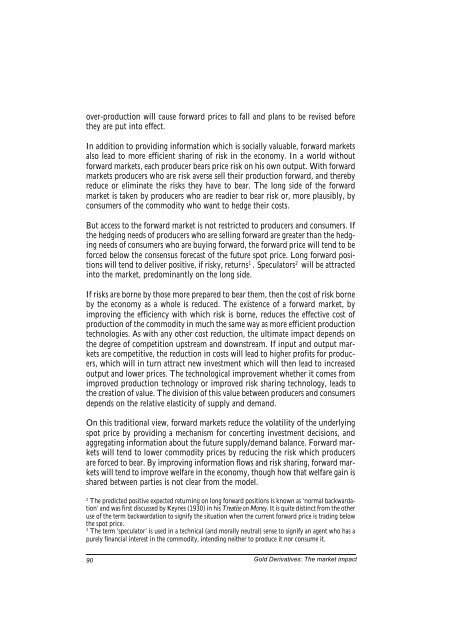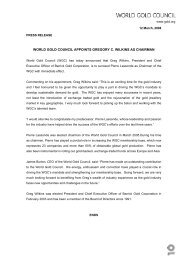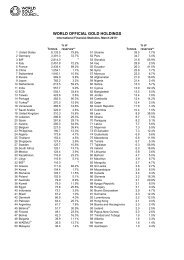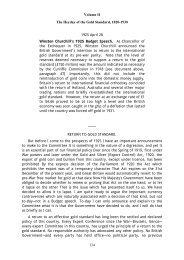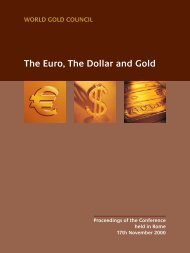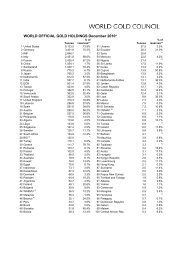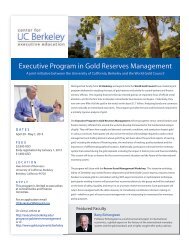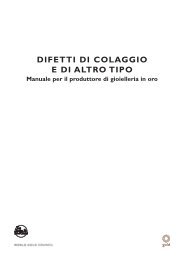Gold Derivatives: Gold Derivatives: - World Gold Council
Gold Derivatives: Gold Derivatives: - World Gold Council
Gold Derivatives: Gold Derivatives: - World Gold Council
You also want an ePaper? Increase the reach of your titles
YUMPU automatically turns print PDFs into web optimized ePapers that Google loves.
over-production will cause forward prices to fall and plans to be revised before<br />
they are put into effect.<br />
In addition to providing information which is socially valuable, forward markets<br />
also lead to more efficient sharing of risk in the economy. In a world without<br />
forward markets, each producer bears price risk on his own output. With forward<br />
markets producers who are risk averse sell their production forward, and thereby<br />
reduce or eliminate the risks they have to bear. The long side of the forward<br />
market is taken by producers who are readier to bear risk or, more plausibly, by<br />
consumers of the commodity who want to hedge their costs.<br />
But access to the forward market is not restricted to producers and consumers. If<br />
the hedging needs of producers who are selling forward are greater than the hedging<br />
needs of consumers who are buying forward, the forward price will tend to be<br />
forced below the consensus forecast of the future spot price. Long forward positions<br />
will tend to deliver positive, if risky, returns 1 . Speculators 2 will be attracted<br />
into the market, predominantly on the long side.<br />
If risks are borne by those more prepared to bear them, then the cost of risk borne<br />
by the economy as a whole is reduced. The existence of a forward market, by<br />
improving the efficiency with which risk is borne, reduces the effective cost of<br />
production of the commodity in much the same way as more efficient production<br />
technologies. As with any other cost reduction, the ultimate impact depends on<br />
the degree of competition upstream and downstream. If input and output markets<br />
are competitive, the reduction in costs will lead to higher profits for producers,<br />
which will in turn attract new investment which will then lead to increased<br />
output and lower prices. The technological improvement whether it comes from<br />
improved production technology or improved risk sharing technology, leads to<br />
the creation of value. The division of this value between producers and consumers<br />
depends on the relative elasticity of supply and demand.<br />
On this traditional view, forward markets reduce the volatility of the underlying<br />
spot price by providing a mechanism for concerting investment decisions, and<br />
aggregating information about the future supply/demand balance. Forward markets<br />
will tend to lower commodity prices by reducing the risk which producers<br />
are forced to bear. By improving information flows and risk sharing, forward markets<br />
will tend to improve welfare in the economy, though how that welfare gain is<br />
shared between parties is not clear from the model.<br />
2<br />
The predicted positive expected returning on long forward positions is known as ‘normal backwardation’<br />
and was first discussed by Keynes (1930) in his Treatise on Money. It is quite distinct from the other<br />
use of the term backwardation to signify the situation when the current forward price is trading below<br />
the spot price.<br />
3<br />
The term ‘speculator’ is used in a technical (and morally neutral) sense to signify an agent who has a<br />
purely financial interest in the commodity, intending neither to produce it nor consume it.<br />
90<br />
<strong>Gold</strong> <strong>Derivatives</strong>: The market impact


